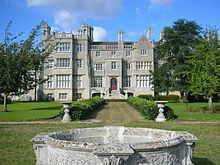Ramsey Abbey: Difference between revisions
Extended confirmed users 111,204 edits |
Extended confirmed users 111,204 edits |
||
| Line 13: | Line 13: | ||
In the order of precedence for abbots in Parliament, Ramsey was third after [[Glastonbury Abbey|Glastonbury]] and [[St Alban's Abbey|St Alban's]].<ref name=CE>{{cite Catholic Encyclopedia|wstitle=Ramsey Abbey|volume=12}}</ref> |
In the order of precedence for abbots in Parliament, Ramsey was third after [[Glastonbury Abbey|Glastonbury]] and [[St Alban's Abbey|St Alban's]].<ref name=CE>{{cite Catholic Encyclopedia|wstitle=Ramsey Abbey|volume=12}}</ref> |
||
The abbey prospered until the [[Dissolution of the Monasteries]] and was an international centre of Hebrew scholarship in the late Middle Ages. Stone from the abbey was used to build [[Gonville and Caius College, Cambridge]], [[King's College, Cambridge]] and [[Trinity College, Cambridge]]. The Abbey lands were sold to Sir [[Richard Williams (alias Cromwell)]].<ref name=CE/> |
The abbey prospered until the [[Dissolution of the Monasteries]] and was an international centre of Hebrew scholarship in the late Middle Ages. Stone from the abbey was used to build [[Gonville and Caius College, Cambridge]], [[King's College, Cambridge]] and [[Trinity College, Cambridge]]. The Abbey lands were sold to Sir [[Richard Williams (alias Cromwell)]].<ref name=CE/> Sir Henry Cromwell started to build the present country house (now a school) on the site. |
||
In 1737 the abbey was bought by [[Coulson Fellowes]], MP for [[Huntingdonshire (UK Parliament constituency)|Huntingdonshire]] from 1741 to 1761. It passed down through several generations of Fellowes who became the [[Baron de Ramsey|Barons de Ramsey]]. |
In 1737 the abbey was bought by [[Coulson Fellowes]], MP for [[Huntingdonshire (UK Parliament constituency)|Huntingdonshire]] from 1741 to 1761. It passed down through several generations of Fellowes, who became the [[Baron de Ramsey|Barons de Ramsey]], during which time the house was substantially enlarged. In 1931 the family moved their seat to [[Abbots Ripton|Abbots Ripton Hall]] at the coming of age of [[John Ailwyn Fellowes, 4th Baron de Ramsey| the 4th Baron]] and in 1937 leased the building for 99 years to Ramsey Abbey School. In 1952 they donated the gatehouse to the National Trust, who allow it to used as part of the school. <ref> {{cite web | url = http://www.ramseyabbey.co.uk/Abbey%20School/fellowes_family.htm| title= Fellowes Family|accessdate = 12 May 2013}} </ref> |
||
==The Abbey today== |
==The Abbey today== |
||
Revision as of 20:19, 12 May 2013

Ramsey Abbey is a former
History
Ramsey Abbey was founded in 969 by Saint
A Prior and twelve monks formed the original foundation. The Abbey itself was then situated on a peninsula of gravel, known as Bodsey Island, with the impassable fen to three sides. The chapel was replaced by a large, stone-built church over the next five years and thus remained until the Norman Abbot created a much grander project in the 12th century. It was thought to have been founded by Earl Ailwyn (Æthelwine), an effigy of whom is thought to be within the Abbey dating from 1230.
Considerable damage was inflicted upon the Abbey by
At the time of the Dissolution in 1539 there were still 34 monks.
In the order of precedence for abbots in Parliament, Ramsey was third after
The abbey prospered until the
In 1737 the abbey was bought by
The Abbey today

The town's parish church of St Thomas Becket was built ca. 1180-90 as a hospital, infirmary or guesthouse of the abbey. It was originally an aisled hall with a chapel at the east end with a vestry on the north side and the warden's lodgings on the south, but both these have been demolished. The building became the parish church ca. 1222.
The
Ramsey Abbey house - the former 17th century home of Sir Henry Cromwell, is currently used to house 6th form facilities and to accommodate lessons.
Part of the gatehouse was removed by the son and heir of Sir Richard (Sir Henry Williams (alias Cromwell)) to form the main gateway to Hinchingbrooke House in Huntingdon, his newly built winter residence.[6]
Burials
- Cnut the Great
References
- ^ a b Herbermann, Charles, ed. (1911). . Catholic Encyclopedia. Vol. 12. New York: Robert Appleton Company.
- ^ "Fellowes Family". Retrieved 12 May 2013.
- ^ http://www.nationaltrust.org.uk/ramsey-abbey-gatehouse/
- ^ Ramsey town website
- ^ The new establishment "The Abbey College, Ramsey" was formed from the amalgamation of Ramsey Abbey School with the adjacent Ailwyn School and has been operational from September 2006, leaving the previous two names defunct
- ^ "About Hinchingbrooke House". Hinchingbrooke House and Performing Arts Centre.
{{cite web}}: External link in|publisher=

